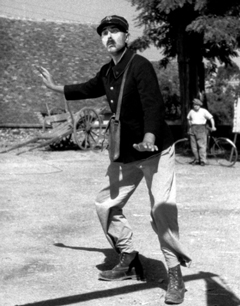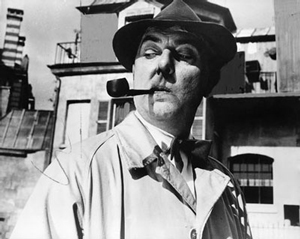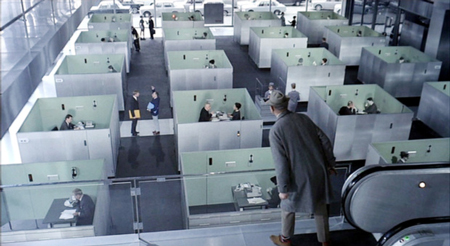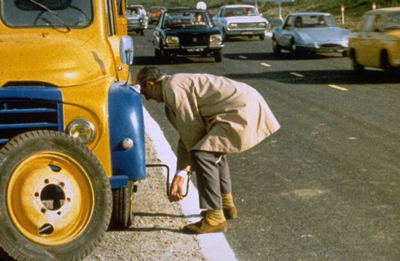|
|
Reviewed by Glenn Erickson
Criterion has been releasing Jacques Tati's films for years, but recent restorations by the heirs of the great writer-director-performer have motivated this new set containing most of his known directing work. Except for his numerous TV appearances and acting jobs in films by Claude Autant-Lara, Tati mostly worked independently, creating a wholly original comic character and refining visual comedy in increasingly complex works of art. In addition to his six feature films (Jour de Fête, Monsieur Hulot's Holiday, Mon Oncle, PlayTime, Trafic and Parade) the Blu-ray collection The Complete Jacques Tati collects five of Tati's short subjects: On demande une brute, Gai dimanche, Soigne ton gauche, L'école des facteurs, Cours do Soir, and two more by his daughter Sophie Tatischeff, Dégustation maison and Forza Bastia.
Tati was an artist in the mold of the great silent comedians, combining aspects of Chaplin and Keaton but answering to his own sophisticated muse. Much of his comedy is physical foolishness learned from stage experience, like his predecessors. Like them he sustained his career by inventing an original, flexible screen character. Tati's Monsieur Hulot is a tall, angular fellow in a raincoat and rain hat, who carries an umbrella and often smokes a pipe. Angular in repose and tentative in motion, Hulot is always trying to understand what's going on, or adjust to a strange environment while dealing with people that take no notice of his problems. He's polite, inoffensive and friendly, but also a mostly solitary fellow. He's forever negotiating a world of architectural, mechanical, and social complications. The world doesn't conspire against him but instead seems engineered to confound ordinary humans.

In 1949's Jour de Fête Tati plays François, a rural postman that he already 'invented' in his 1946 short L'école des facteurs. From his first feature Tati is concerned with creating little social 'worlds', in this case an entire village complete with individualized inhabitants. François helps with the decorations for a traveling fair, ordering people about as if his uniform made him an expert in all matters. A newsreel trumpeting the advances of American postmen (they parachute from airplanes) inspires him to modernize and systematize his delivery work. This leads to mechanical gags making fun of the progressive programs then being enacted in the French countryside. It's a gentle, winning comedy that became extremely popular in France.
Tati shot the film in B&W but also in an experimental color process that was abandoned by its company before prints could be made, forcing a B&W-only release. Tati designed the whole show for color, with buildings and doors specially painted to Tati's thematic formula. The color was to have played an important role in some of the jokes. Criterion's presentation gives us the original B&W release, plus a selectively colored 1964 reissue that colors selected objects. A third version from 1995 version uses emerging technology to finally display full-color images, 45 years after they were filmed. The hues are patchy and the system has contrast issues, but it is indeed a full-color print. A featurette is included about the restoration of the color version, and a second visual essay by Stéphane Goudet examines the development of Tati's style of screen comedy. (Criterion's full list of extras for the collection is reprinted below.)
Monsieur Hulot's Holiday introduces Tati's famed character and fits him into a loose series of episodes about a leisurely beach vacation. Hulot joins in the mad rush at the train station and tries to get along with his fellow holiday-makers, while struggling with beach umbrellas, tennis equipment, etc.. The jokes build and peak organically, much like those of Buster Keaton, and the careful pace gives us time to appreciate the context of his gags. Some can be likened to detailed single panel cartoons, like those that used to appear in the humor magazine Punch. Searching a busy frame for clues, you might find M. Hulot in the background of a shot, while other business transpires up front. Staying wide, Tati's comedy always has a context of depth, with the frame enclosing the world rather than moving about to keep up with it. Tati understands the visual comedy of his American predecessors, and adds wrinkles that make it seem as if he's extending their method to the next step -- his work seems like 'calculated inspiration.'

Criterion presents Monsieur Hulot's Holiday in both a 1978 rerelease version and a 1953 original. For new releases, he often tinkered with his work.
For 1958's Mon Oncle Tati is finally able to work in glorious color, and on a much bigger canvas -- the film is half an hour longer than Holiday. This time around Tati finds his main comedy theme of satirizing modern inventions meant to make life easier. The delicate comedy centers first on a futuristic 'designer' house and then on an automated plastics factory. Major effort was put into the design of the sets. The home is a marvel of impish trickery -- it looks like abstract art, has all manner of automatic inventions, but Monsieur Hulot finds it impossible to inhabit without creating disasters. Meanwhile, the actual owners of the house are so proud to be so 'progressive', that they don't seem to mind that nothing works as intended. The jokes are as inventively clever as Tex Avery cartoons about homes of the future; the trend was celebrated for a few years with Disneyland's Monsanto House. The film's sweet-natured satire, bright colors and overall inventiveness made it an art house hit in America, where it won an Oscar for Best Foreign Film.
Criterion also presents Tati's English-language version, My Uncle, which is edited differently. Four separate featurettes cover the making of the picture and celebrate its original designs.
1967's PlayTime is one of the most expensive experimental films ever made. It's the culmination of Tati's art and the logical next step from the 'cute satire' format of Mon Oncle Tati knew that his M. Hulot character was really a way to explore society, and in his giant production he takes on modern life on an enormous scale. Hulot is his normal self, but is reduced to a misplaced cog in the machine of modern live. He's carrying out some business errand in Paris, which has been transformed into a forest of glass and steel buildings that could be anywhere in the world. One of the jokes even has travel posters displaying identical buildings. Hulot becomes lost in an architectural maze that defeats the individual, with glass walls that keep people apart instead of bringing them together.

Filmed in 70mm and often framed extremely wide, PlayTime puts us in the position of finding the jokes in the frame. Almost always, more than one gag is playing out on the giant screen. The movie often resembles a giant 'where's Waldo' illustration, in which we have to find our leading character. The choreographic organization to make the film work is dizzying -- PlayTime has been rightfully compared to Kubrick's 2001. With nary a verbal explanation, we contemplate Tati's ideas about the loss of privacy and individuality.
The film's second half is an equally impressive extended comedy construction centered on the opening of a swank restaurant, where everything humanly possible goes wrong. But the chaos is taken as a good development: the human element triumphs when people must improvise to have a good time. The once-baffled and ungainly Hulot seems liberated. He becomes the life of the party, even charming a visiting American tourist. It's an amazing delight.
Criterion reports that this 2013 restoration was scanned from original 70mm film elements (it must have been something to see in that format). The featurettes are amazing to see -- Tati constructed an enormous set the size of a couple of city blocks, complete with forced-perspective skyscrapers that could be rolled around like scenery flats. As might be expected with a concept as revolutionary as this one, Tati experienced a financial disaster that spelled the end of his explorations beyond the limits of conventional comedy. He lost most of his estate, including the rights to his own films.

Tati's last two films after PlayTime are not as impressive -- he no longer had complete freedom. M. Hulot returns in 1971's Trafic, a show that returns to the level of Holiday but with less inspiration. Instead of a modern house, Hulot is a car designer with a 'camping car' whose extra features will be displayed at a car show in Amsterdam. Some of the gags are clever but Hulot looks older and more tired. Tati's final film Parade was made for Swedish television and boils down to a series of episodes covering various performances. Tati adds a number of personal touches and uses the circus audience as performers as well. He even uses cardboard cut-out people, as he did in PlayTime. He remains the central star, serving as master of ceremonies and performing several skits, in what seems a look-back at his career. The disc extras connect the show with Tati's own beginnings as a music hall actor in the 1930s.
Criterion's Blu-ray of The Complete Jacques Tati is a treasure box of great film work. Tati expanded his 'artistic footprint' for each of his first four pictures, and it is fascinating to see how he moved forward without repeating himself. Most all of the transfers are improvements. I've never seen Jour de fête or Parade before, but Monsieur Hulot's Holiday and Mon oncle look better than what I've seen. PlayTime always looked great and really hasn't changed. Other sites are saying that its color is too cold but that choice would seem appropriate to the film's theme.

The Criterion Collection's disc producer Kate Elmore went to multiple sources to round up the interesting short subjects. As I proceeded from disc to disc I found myself looking forward to the next visual essay by Stéphane Goudet. Last year's Pierre Etaix boxed set was a major revelation, and this new collection does justice to the great Jacques Tati.
On a scale of Excellent, Good, Fair, and Poor,
The Complete Jacques Tati Blu-ray
rates:
Movies: Jour, Holiday, Oncle, PlayTime: Excellent; Trafic: Good; Parade: Good --
Video: Excellent
Sound: Excellent
Supplements (from Criterion's web page):
New digital restorations of all six feature films, with uncompressed monaural soundtracks on the Blu-rays of Jour de fête, Monsieur Hulot's Holiday, Mon oncle, Trafic, and Parade and 3.0 surround DTS-HD Master Audio soundtrack on the Blu-ray of PlayTime. New digital restorations of all seven short films: On demande une brute (1934), Gai dimanche (1935), Soigne ton gauche (1936), L'école des facteurs (1946), Cours du soir (1967), Forza Bastia (1978), and Dégustation maison (1978). Two alternate versions of Jour de fête, a partly colorized 1964 version and the full-color 1995 rerelease version. Original 1953 theatrical release version of Monsieur Hulot's Holiday. Also My Uncle, the version of Mon oncle that director Jacques Tati created for English-language audiences. Introductions by actor and comedian Terry Jones to Monsieur Hulot's Holiday, Mon oncle, and PlayTime. Archival video and audio interviews with Tati. In the Footsteps of Monsieur Hulot, a 1989 documentary about Tati's beloved alter ego. Five visual essays and a classroom lecture by Tati expert Stéphane Goudet. New interview with critic Michel Chion on Tati's sound design. "Jour de fête": In Search of the Lost Color, a 1988 documentary on the restoration of the film to Tati's original color vision. Once Upon a Time . . . "Mon oncle," a 2008 documentary on the making of the film. Everything Is Beautiful, a 2005 piece on the fashion, furniture, and architecture of Mon oncle. Selected-scene commentaries on PlayTime by Goudet, theater director Jérôme Deschamps, and critic Philip Kemp. Tativille, a documentary shot on the set of PlayTime that includes the set's destruction. Beyond "PlayTime," a short 2002 documentary featuring on-set footage. "An Homage to Jacques Tati," a 1982 program featuring Tati friend and set designer Jacques Lagrange. Interview from 2006 with PlayTime script supervisor Sylvette Baudrot. Tati Story, a short biographical film from 2002. Alternate international soundtracks for Monsieur Hulot's Holiday and PlayTime. Trailers. A booklet featuring essays by critics James Quandt, Jonathan Rosenbaum, Kristin Ross, and David Cairns.
Deaf and Hearing-impaired Friendly?
YES; Subtitles: English
Packaging: Seven card and plastic disc holders with 64-page booklet in heavy card sleeve
Reviewed: October 26, 2014

Text © Copyright 2014 Glenn Erickson
See more exclusive reviews on the Savant Main Page.
The version of this review on the Savant main site has additional images, footnotes and credits information, and may be updated and annotated with reader input and graphics.
Return to Top of Page
|



